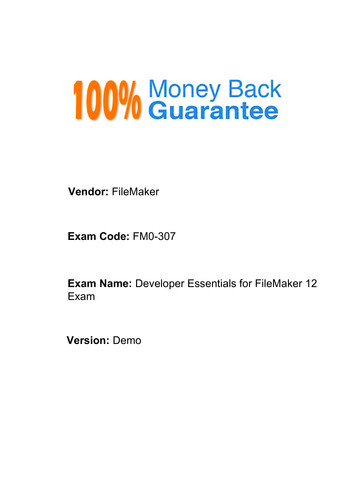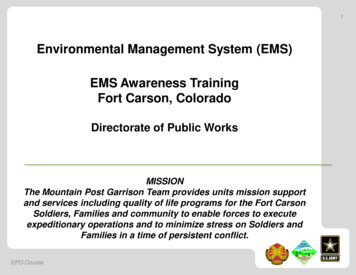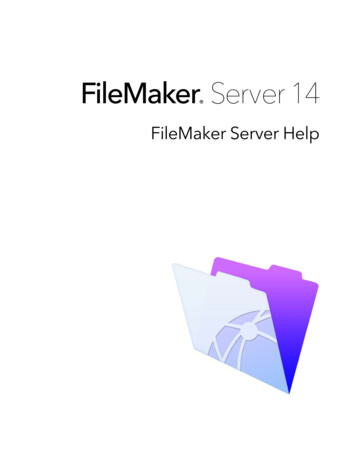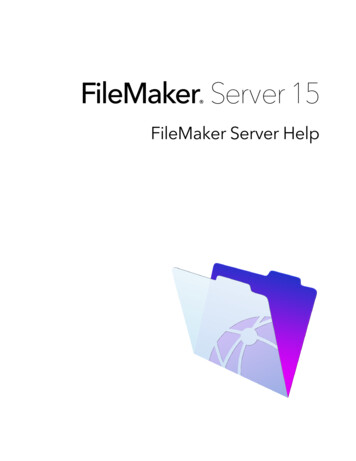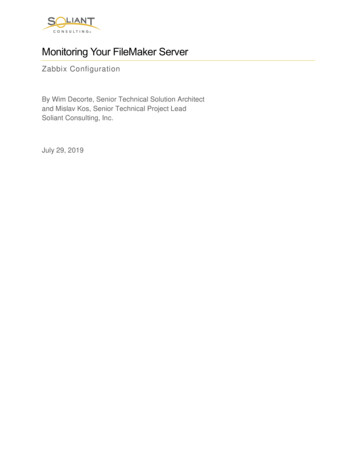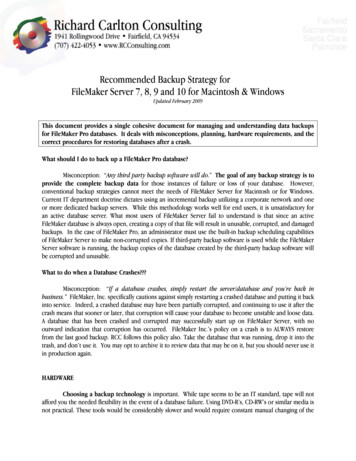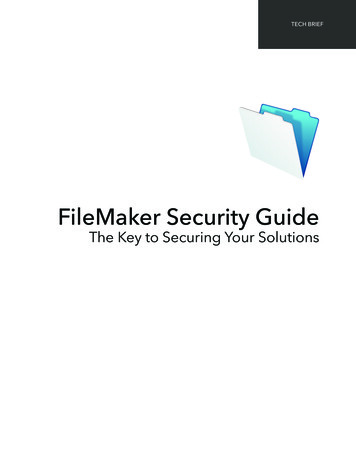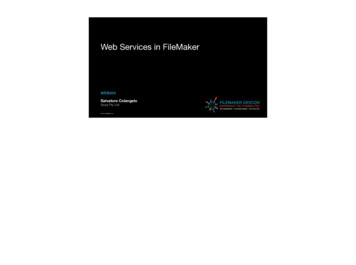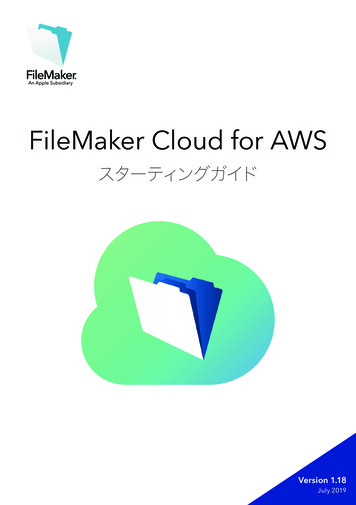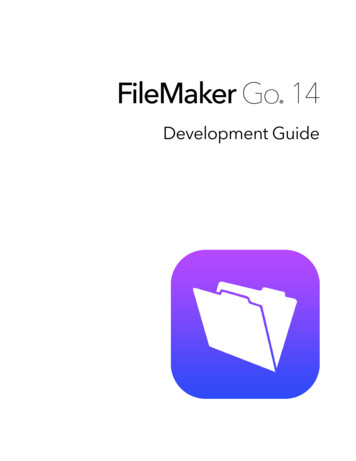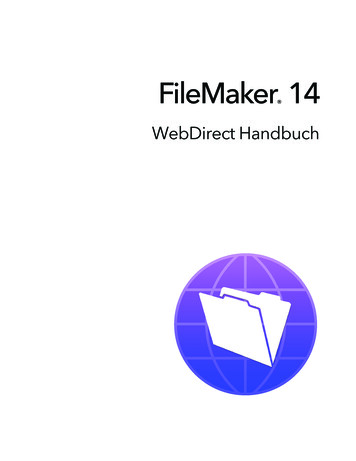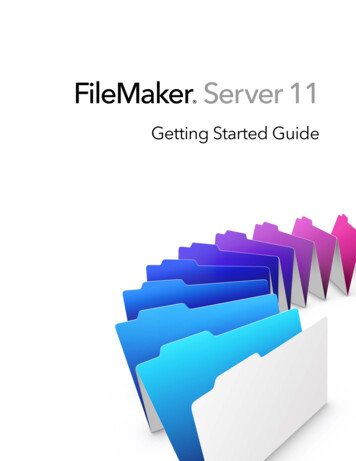
Transcription
FileMaker Server 11 Getting Started Guide
2004–2010 FileMaker, Inc. All Rights Reserved.FileMaker, Inc.5201 Patrick Henry DriveSanta Clara, California 95054FileMaker and Bento are trademarks of FileMaker, Inc. registered in the U.S. and other countries. The file folder logo and the Bento logoare trademarks of FileMaker, Inc.FileMaker documentation is copyrighted. You are not authorized to make additional copies or distribute this documentation withoutwritten permission from FileMaker. You may use this documentation solely with a valid licensed copy of FileMaker software.All persons, companies, email addresses, and URLs listed in the examples are purely fictitious and any resemblance to existing persons,companies, email addresses, or URLs is purely coincidental. Credits are listed in the Acknowledgements documents provided with thissoftware. Mention of third-party products and URLs is for informational purposes only and constitutes neither an endorsement nor arecommendation. FileMaker, Inc. assumes no responsibility with regard to the performance of these products.For more information, visit our website at www.filemaker.com.Edition: 01
ContentsPrefaceSystem requirements for FileMaker ServerMac OS X and Mac OS X Server version 10.5.8Mac OS X and Mac OS X Server version 10.6.1Windows Server 2003Windows Server 2008 and Windows 7System requirements for Admin Console and site assistantsSupported client applicationsAbout the license keyUpgrading the FileMaker Server 11 licenseWhere to go from here7788899101010Chapter 1Installation quick startBefore you beginConsidering performanceInstalling FileMaker Server on a single machineNext steps11111220Chapter 2Deploying FileMaker Server across multiple machinesDeployment alternativesOne-machine deploymentTwo-machine deploymentThree-machine deploymentInstalling on multiple machinesBefore you beginInstalling on the worker machinesInstalling on the master machineInstallation notesNext steps21222324252526283939
4FileMaker Server Getting Started GuideChapter 3Testing your deploymentUsing the FileMaker Server Technology Tests pageTroubleshootingDeployment assistant reports that the web server test failedDeployment assistant does not start after installationAdmin Console doesn’t start after deployment on master machineAdmin Console Start Page says to install Java when it’s already installedCannot start Admin Console from a remote machineClients cannot see databases hosted by FileMaker ServerThe Mac OS web server fails during startup414343444444444545Chapter 4Administration overviewAbout FileMaker Server Admin ConsoleUsing Admin Console to administer FileMaker ServerStarting Admin ConsoleUploading a databaseBacking up databasesVerifying the integrity of databasesHosting databases connected to ODBC data sourcesEnabling ODBC data source single sign-on (Windows only)Running a server-side scriptFileMaker scriptsSystem-level scriptsScript SequencesSending messages to FileMaker Pro clientsViewing log file entries in Admin ConsoleEmailing notifications474849505051515152535353535454
5Chapter 5Upgrading or moving an existing installationStep 1. Save your schedules and administrator groupsStep 2. Note your FileMaker Server settingsWhere to note settings for FileMaker Server 9, 10, or 11Step 3. Stop FileMaker ServerStep 4. Make a copy of databases, scripts, and plug-insFileMaker Server 9 filesFileMaker Server 10 files (default installation)FileMaker Server 10 files (non-default installation)FileMaker Server 11 files (default installation)FileMaker Server 11 files (non-default installation)Step 5. Uninstall FileMaker ServerUninstalling FileMaker Server 9Uninstalling FileMaker Server 10 or 11Step 6. Install FileMaker Server 11Step 7. Move files to the proper locationStep 8. Load your schedules and administrator groupsStep 9. Recreate schedules and configure5556565657575757575858585859606061Chapter 6Setting up the web serverEnabling the Apache web server in Mac OS XEnabling the IIS web server in WindowsSetting up authentication for a Windows IIS website636364Chapter 7Additional resourcesProduct documentationUsing FileMaker Server documentationWhere to find PDF documentationRegistration and customer supportCheck for software updates6767676868Index69
6FileMaker Server Getting Started Guide
PrefaceWelcome to FileMaker Server 11. FileMaker Server is a dedicated database server that opensFileMaker Pro files, makes them available to other machines on a network, and publishes FileMaker data inweb pages on the Internet or a company’s intranet. FileMaker Pro is an application for creating andmodifying database files. Clients use FileMaker Pro to access database files hosted by FileMaker Server.Before you install, confirm that your machines meet the minimum requirements listed below.System requirements for FileMaker ServerThis section provides the minimum and recommended requirements for running FileMaker Server on thefollowing systems:11111Mac OS X and Mac OS X Server version 10.5.8 and 10.6.1 (Intel-based computers only)Windows Server 2003 Standard Edition SP2Windows Server 2008 Standard Edition SP2Windows Server 2008 R2Windows 7 Professional EditionNote FileMaker Server is supported on Windows 7 for single machine installations for development use.Windows 7 is not supported for deployment use on multiple machine installations.For information on systems that are not listed here, see www.filemaker.com.Mac OS X and Mac OS X Server version mCPUDual Core Intel1.67 GHz Intel Core DuoRAM4 GB2 GBHard drive80 GB80 GBOS10.5.810.5.8Web serverApache 1.3Apache 1.3PHPPHP 5.2.11PHP 5.2.11Java5.0 (32 bit, 1.5.0)5.0 (32 bit, 1.5.0)
8FileMaker Server Getting Started GuideMac OS X and Mac OS X Server version mCPUDual Core IntelDual Core IntelRAM8 GB4 GBHard drive80 GB80 GBOS10.6.110.6.1Web serverApache 2.xApache 2.xPHPPHP 5.3PHP 5.3Java6.0 (32 bit, 1.6.0)6.0 (32 bit, 1.6.0)RecommendedMinimumCPUDual CPU/Core DuoPentium 3.4 GHzRAM4 GB2 GBHard drive80 GB80 GBOSWindows Server 2003 Standard Edition Windows Server 2003 Standard EditionSP2SP2Web serverIIS 6.0IIS 6.0PHPPHP 5.2.11PHP 5.2.11Java6 (32 bit, Update 16)6 (32 bit, Update 16)Bonjour1.0.61.0.6Microsoft Visual C 2008 Redistributable (x86)9.0.30729.19.0.30729.1Windows Server 2003RequirementHardwareSoftwareWindows Server 2008 and Windows ual CPUCore DuoRAM4 GB2 GBHard drive80 GB80 GBOS1 Windows Server 2008 Standard1 Windows Server 2008 StandardEdition SP1Edition SP11 Windows Server 2008 R21 Windows 7 Professional Edition1 Windows Server 2008 R21 Windows 7 Professional EditionWeb serverIIS 7.0 (Native Mode)IIS 7.0 (Native Mode)PHPPHP 5.2.11PHP 5.2.11Java6 (32 bit, Update 16)6 (32 bit, Update 16)Bonjour1.0.61.0.6Microsoft Visual C 2008 Redistributable (x86)9.0.30729.19.0.30729.1Note On Windows 64-bit editions, FileMaker Server requires the 32-bit version of Java 6 Update 16.
Preface9System requirements for Admin Console and site assistantsYou can use the applications that come with FileMaker Server — FileMaker Server Admin Console, PHPSite Assistant, and XSLT Site Assistant — on machines that have network access to FileMaker Server. OnMac OS, these applications require Java Runtime Environment version 5 at a minimum. On Windows, the32-bit version of Java 6 Update 16 is required. The supported platforms for these applications are:1111111Mac OS X and Mac OS X Server version 10.5.8 and 10.6.1 (Intel-based computers only)Windows XPWindows Server 2003 Standard Edition SP2Windows Server 2008 Standard Edition SP2Windows Server 2008 R2Windows Vista Business Edition SP2Windows 7 Professional EditionSupported client applicationsFileMaker Server supports the following client applications:1 FileMaker Pro 9, 10, and 11.1 ODBC (Open Database Connectivity) and JDBC (Java Database Connectivity) client applications usingthe FileMaker client drivers (FileMaker Server Advanced license required).1 Web browsers (or other applications) accessing data through the FileMaker Server 11 Web Publishing Engine.For Instant Web Publishing (FileMaker Server 11 Advanced license required), the supported webbrowsers are:Windows 7, Windows Vista, Windows XP,Windows Server 2003, or Windows Server 2008Mac OS X (10.5.8 or 10.6.1)Internet Explorer 7 or 8Safari 4.xFirefox 3.5Firefox 3.5Safari 4.xYour copy of FileMaker Server supports one of the following client configurations:FileMaker ServerFileMaker Server AdvancedUp to 250 FileMaker Pro clientsUnrestricted number FileMaker Pro clientsaUp to 125 hosted databasesUp to 125 hosted databasesUp to a total of 100 Custom Web Publishing sessionsUp to a total of 100 Custom Web Publishing and Instant WebPublishing sessionsUp to a total of 50 ODBC and JDBC clientsa. Note: Although FileMaker Server Advanced allows an unrestricted number of simultaneous FileMaker Pro client connections, most operatingsystems impose their own limits on the number of network connections and open files that a process may use. This operating system limit setsthe effective limit on the number of simultaneous client connections.
10FileMaker Server Getting Started GuideAbout the license keyFileMaker software comes with a unique, 35-character license key. Do not lose this license key. Werecommend that you keep the license key in a safe place in case the software ever needs to be reinstalled.You can find your license key(s) on the back of the CD sleeve. If you paid for your software electronically,you received an email with a link to a PDF file with your license key.The license key ensures adherence to the single user license agreement, which generally allows for use ofone (1) copy of the Software on a single machine or a single multiple-machine deployment at a time (referto your Software License). If the license key is invalid or if another copy of the software installed with thatsame license key is running on the network, the FileMaker Server software displays an error message anddoes not start.You can choose to deploy FileMaker Server components across multiple machines that work together toform a single FileMaker Server deployment. You must have a unique license key for each multiple-machinedeployment, or obtain a volume license for more than one deployment. You must license one copy ofFileMaker Server for each deployment.Upgrading the FileMaker Server 11 licenseTo upgrade your license from a trial version of FileMaker Server 11 or from FileMaker Server 11 toFileMaker Server 11 Advanced on the same machine, you must change your FileMaker Server license key.To change the FileMaker Server license of an existing deployment:1. From the FileMaker Server Admin Console, choose Help menu Update FileMaker Server License. See“Starting Admin Console” on page 49 for how to start the Admin Console.2. In the Change License Key dialog box, enter the information required, then click Update.Note To move your FileMaker Server 11 deployment to a new machine or to upgrade from an earlierversion of FileMaker Server, see chapter 5, “Upgrading or moving an existing installation.”Where to go from here1 To install on a single machine, see chapter 1, “Installation quick start.”1 To install on multiple machines, see chapter 2, “Deploying FileMaker Server across multiple machines.”1 To move from an existing installation of FileMaker Server, see chapter 5, “Upgrading or moving anexisting installation.”
Chapter 1Installation quick startThis chapter explains how to install FileMaker Server on a single machine.Before you beginHere is a list of things you must do before installing FileMaker Server:1 To install on more than one machine, see chapter 2, “Deploying FileMaker Server across multiple machines.”1 To enable web publishing, make sure the web server is enabled. See chapter 6, “Setting up the web server.”1 If your server computer has a firewall, open the necessary ports in the firewall so that FileMaker Servercan communicate with users and administrators:1 Required on all deployments: 5003, 16000, and 16001.1 Additionally required for web publishing: 80 (HTTP) or 443 (HTTPS).1 Ports 5013, 16004, 16006, 16008, 16010, 16012, 16014, 16016, 16018, and 50003 must be availableon the machine, but not open in the firewall. For more information, see “One-machine deployment”on page 22.1 To upgrade from an earlier version of FileMaker Server, see chapter 5, “Upgrading or moving an existinginstallation.” To upgrade to FileMaker Server Advanced, see “Upgrading the FileMaker Server 11license” on page 10.1 Locate your license key. See “About the license key” on page 10.1 If you are currently running FileMaker Pro on the same machine, you must quit FileMaker Pro beforeinstalling FileMaker Server.Also keep in mind the following:1 You cannot run two different versions of FileMaker Server on the same machine at the same time.1 Because some DHCP servers cycle IP addresses, FileMaker recommends using a static IP address.Considering performanceFor best performance, run FileMaker Server on a dedicated machine reserved for use as a database server.When FileMaker Server is hosting many clients or a large number of database files, it uses a high level ofprocessor, hard disk, and network capacity. Other processor-intensive software or heavy network traffic onthe same machine will cause FileMaker Server to run more slowly and degrade the performance ofFileMaker Pro on client machines.
12FileMaker Server Getting Started GuideTo improve performance:1 Avoid installing FileMaker Server on a machine that is a user’s primary workstation.1 Avoid using the machine running FileMaker Server as an email, print, or network file server.1 Do not use system backup software to back up databases hosted by FileMaker Server. Instead useFileMaker Server Admin Console to schedule backups of databases.1 Do not use anti-virus software to scan the folders that contain hosted database files.1 Disable screen savers and sleep (or hibernate and standby) mode on the server. These features reduceperformance or suspend access to hosted databases.1 Use a fast hard disk, multiple-disk RAID system, or reliable Storage Area Network (SAN) for the hosteddatabases.1 Turn off Indexing Service (Windows), Spotlight (Mac OS), or any other third-party file indexingsoftware. This feature reduces performance.Installing FileMaker Server on a single machine1. Insert the CD into the drive or follow your electronic download instructions.2. Double-click the installation icon.Mac OSWindows3. Mac OS: Enter your Mac OS user name and password.4. Windows: If a User Account Control alert appears, click Yes.5. Windows: Select a language, then click OK.6. Windows: If you do not have the Microsoft Visual C 2008 Redistributable Package (x86), JavaRuntime Environment version 6 update 16, or Bonjour for Windows installed, you are prompted to allowthe FileMaker Server installer to install the missing software components. Click Install and follow theonscreen instructions.For more information, see “Installation notes” on page 39.
Chapter 1 Installation quick start137. Windows: To begin installation, click Next.8. Read the Before You Begin information. If there is a task you did not do, quit the installer and do thetask. If you are ready to install FileMaker Server, click Continue (Mac OS) or Next (Windows).9. Review and accept the end user license agreement.10. Windows: Select a destination folder, then click Next.Note On Windows, you can select a non-default location. See “Installation notes” on page 39.11. Select Single Machine and click Next.12. Enter your license key information.13. Windows: Click Next.14. Click Install.Note On Mac OS, if you do not have Java Runtime Environment version 5 at a minimum installed, youare prompted to use Software Update to install it and then re-run the installer. If Bonjour is not running,you are prompted to run it. For more information about Java and Bonjour installation, see “Installationnotes” on page 39.FileMaker Server begins to install. This process may take several minutes.
14FileMaker Server Getting Started Guide15. After the software has been successfully installed, start the Deployment assistant.1 Windows: In the last step of the installer, select Start the Deployment assistant, then click Finish.1 Mac OS: Click Continue. (If necessary, see “Deployment assistant does not start after installation” onpage 44.)WindowsMac OSIf you want, you can stop now and start the Deployment assistant later. To deploy FileMaker Server at alater time:1 Windows: Click Start menu Programs FileMaker Server FMS 11 Start Page.1 Mac OS: Double-click the FMS 11 Start Page shortcut on the desktop.16. A FileMaker Server Start Page opens in the web browser. It may take a few minutes for the AdminConsole to start and the Deployment assistant to appear.Note If the Admin Console and Deployment assistant do not start, see “Deployment assistant does notstart after installation” on page 44.17. Click Run (Windows) if necessary, or click Allow (Mac OS) to respond to the security message.
Chapter 1 Installation quick start1518. In the first step of the Deployment assistant, assign the user name and password you want to usewhenever you log into Admin Console as the server administrator. The server administrator isresponsible for installing and configuring FileMaker Server as well as managing the FileMaker Prodatabases hosted on FileMaker Server. Click Next.Note User Name is not case-sensitive. Password is case-sensitive.19. Specify a name, description, and contact information for this deployment of FileMaker Server, thenclick Next. This information will appear on the FileMaker Server Admin Console Start Page. The ServerName is displayed to FileMaker Pro users in the Open Remote dialog box.
16FileMaker Server Getting Started Guide20. If you purchased a FileMaker Server Advanced license, you can enable a hosted FileMaker Pro file to be a datasource via ODBC and JDBC. Click Yes, enable ODBC/JDBC or No, do not enable ODBC/JDBC. Click Next.Important This feature allows clients to use FileMaker files as data sources using ODBC and JDBC. Thisfeature is not needed to host FileMaker Pro databases that access ODBC data sources. For moreinformation, see FileMaker Pro Help.21. If you want to publish FileMaker data on the internet or intranet, click Yes, enable Web Publishing.Otherwise, click No, do not enable Web Publishing. Then click Next. Continue with step 25 if you are notenabling web publishing.Note To use web publishing, the web server must be installed and running. See chapter 6, “Setting upthe web server.”
Chapter 1 Installation quick start1722. Select the web publishing technologies you want to use and click Next.1 You can install the FileMaker Server supported version of the PHP engine (see “System requirementsfor FileMaker Server” on page 7), or you can use your own PHP engine. If you already have a PHPengine installed and choose to use the FileMaker Server supported PHP engine, your currentlyinstalled PHP engine will be disabled.1 If you use your own PHP engine, you must manually install the FileMaker API for PHP to use PHPpublishing. See FileMaker Server Custom Web Publishing with PHP for more information.Note Instant Web Publishing requires a FileMaker Server Advanced license.
18FileMaker Server Getting Started Guide23. Select a web server and click Next.Note If the Deployment assistant fails to detect the web server, see chapter 6, “Setting up the webserver.” Also be sure that the necessary firewall ports are open. See “Before you begin” on page 11.Note To specify a web server later, select Skip this step and select a web server later and click Next.24. If you see the following Web Server Test Failed step, the Deployment assistant detected but could notcommunicate with the web server. Specify the Protocol, Host address, and Port for the web server andclic
FileMaker Server is a dedicated database server that opens FileMaker Pro files, makes them available to other machines on a network, and publishes FileMaker d
